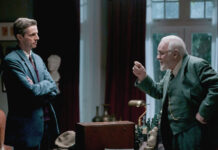Mo Asumang has many professions: she is an actress, singer, author and director. In her documentaries she talks to racists, homophobes, left-wing extremists and misogynists. Here the 59-year-old tells why she “dives into madness with them”.
FOCUS online: Ms. Asumang, what makes you stand out as a director?
Mo Asumang: I take a completely different approach. When it comes to documentaries, I’m not only the director, I’m also the host, so I speak to the protagonists myself. I try to approach people with an open mind, not to pigeonhole them. This applies to everyone I meet in the course of my work. Also for left-wing extremists, homophobes, lateral thinkers, misogynists and racists.
So people who hold extreme views.
Asumang: Right. Normally, as a journalist, you confront such people with certain prior knowledge. You literally put it on them. For me it’s the other way around. I’m trying to discover something. I don’t want to go into such conversations with a lot of knowledge, I want to meet the protagonists with curiosity and ask them my questions from the gut.
Now save articles for later in “Pocket”.
Anyone who looks at your documentaries gets the impression that you have a penchant for extreme subjects. In 2014 you exchanged ideas with racists in the format “The Aryans”, eight years later with misogynists, left-wing extremists and lateral thinkers.
Asumang: Yes. I always tell the protagonists I’m not going to put you in a box, but then you’ll have me on the cheek. So my questions, my curiosity, I dig deeper and deeper. That can be very uncomfortable for my interview partner, i.e. the racist, the misogynist, the left-wing extremist.
Mo Asumang is a director, presenter, author, singer and actress. She studied visual communication and classical singing. Asumang has made a name for herself with her documentaries in particular, and she received numerous awards for “The Aryans”. Asumang gives lectures on racism and xenophobia at schools and universities.
But it seems to be working, they start talking to you.
Asumang: These people tend to encounter people who have preconceived notions and force them on them. With me they notice that it is different. They realize that they are perceived as a person and open up in a completely different way. I think that is important. In the journalism we see on camera, this impartiality is often absent. There’s still room for improvement.
How do you get people like that to talk to you?
Asumang: In the production company we wrote to potential partners. The racists didn’t know I was coming, otherwise they wouldn’t have spoken to me. But I can say that it was incredibly difficult to find contacts. People know full well that if they say certain things in public, they will be pilloried.
In the worst case, they could even face a prison sentence. Sometimes we just couldn’t get any further. Then we said that the interviewer is Mo Asumang. And that actually opened doors. That gave the protagonists a certain security because they knew the conversation would be open and not so one-sided. At least I think so.
What did you ask the racists in “The Aryans”?
Asumang: I have to say that it was also a kind of self-experiment for me. I didn’t go there primarily as a journalist, but as a Mo with a life story characterized by racism. Incidents in my past scared me.
In the conversations with racists, I first tried to survive and not panic, but to be able to listen without my own heartbeat drowning out everything. Then I got involved with the people and tried to find out who they are.
You can see the first four parts of Mo Asumang’s new documentary series here
What did that look like?
Asumang: With the Ku Klux Klan, for example, it was clear to me that the supporters hang people, kill them, all in the name of their beliefs. And has been for hundreds of years. I wanted to know: why? Why do you put yourself above a certain group of people as a white supremacist?
But I also asked the people I spoke to very specifically: Why are you burning a cross? They said they’re doing this for Jesus Christ. I checked. Isn’t it true that Jesus Christ also loves black people? I wanted to know. Then to see how the other person reacts, how he moves, how he tries to express himself is exciting.
As a black woman, interacting with racists is likely to be very challenging.
Asumang: Absolutely. If I face a racist with my dark skin color, then I’m already a question in the room per se. Why is she there? Why does she dare? Why doesn’t she collapse immediately? That does something to people.
After “The Aryans” you brought out a new extreme documentary series. Who did you talk to this time?
Asumang: In “The Men’s Crisis”, for example, I met a misogynist and extreme men’s rights activists. One gave an interview to a nationalist platform at the time Anders Breivik shot dead 77 people in Oslo. I asked him why? And he said he saw no other way to get attention for his men’s issues.
Another has launched a platform called “Women’s Plague” on which extremely misogynist slogans are shared. It said things like “Down with the Fotzokracy”. I asked him what his motivation is. It turned out that behind the man is a wounded soul. His own wife did violence to him.
Surf tip: You can find all the news about the corona pandemic in the FOCUS Online news ticker
So sometimes tragic stories hide behind extreme ideas.
Asumang: Exactly. That’s what’s so interesting to me. Not simply to say that these people are like that, they are mean, but also to ask: Why is that?
How did you experience left-wing extremists? You were also at a demo for an Antifa activist with 5000 leftists for your documentary series.
Asumang: The whole thing is like war, that’s how I perceived it. The situation escalates when a stone is thrown somewhere, when the police use water cannon, when the cycle of violence is followed by another retaliation.
Radical leftists do not want to accept the capitalist system, the entire legal system. Because the conflicts that currently prevail in society – for example gentrification, climate change – are not sufficiently dealt with in their eyes and politicians are not doing enough.
Basically, I can understand that. I also wish for a better world. But the methods some left-wing extremists use to achieve their goals – violence, destruction – are not mine.
How does it get to the point that people think they have to use violence to achieve their goals?
Asumang: You feel powerless, at least that’s one answer. You don’t feel seen.
Insults, physical violence, hatred of black people – a lot comes together. What did you take away from the conversations in your series with extreme protagonists?
Asumang: That they are all human. Who go shopping, have an apartment, went to school at some point. I think most have been taken to extremes by the sense of powerlessness I just spoke of. They withdraw into their own world and act there. And I don’t think many people can get out of it on their own.
Why?
Asumang: Because there are almost only people in her environment who share her ideas.
For some, this is definitely a conscious decision.
Asumang: It could be. Maybe because there is no other way forward. Some may also be bad people, not of good character. But in my opinion, many are in their powerless situation and have drifted away as a result.
Nowadays we have the opportunity to retreat to the Internet and meet like-minded people there – other homophobes, misogynists, racists, radical leftists. You pat each other on the back and get confirmation. It doesn’t come from the critical level represented by society, by other people.
Do all these extreme groups have something in common in your eyes?
Asumang: They’re trapped in their own world. And no longer able to accept critical counter-questions.
Maybe you pulled some of these people out of their bubbles through your films.
Asumang: Yes, there is also some evidence that our talks have changed something. For example, Bonn’s worst misogynist, whom I interviewed for “Men in Crisis”, has now closed his misogynistic platform.
So a small success. How do you explain that?
Asumang: The people I’ve visited are usually amazed at my openness at first, because they expect resistance. But my motto is to dive into madness with them. This is how I give the person I am talking to the feeling that someone is listening to them. At this level you can ask critical questions. I’m not blustering, I’m trying to be empathetic.
Don’t you sometimes think: if there are so many extreme groups in society, something is going wrong. Or does it all have to do with freedom of expression?
Asumang: Diversity of opinion is in itself the greatest asset we have. It has to be there, we have to question things, otherwise we won’t get anywhere. Of course there are also extreme margins, but I think they are only dangerous when there is no dialogue. That is currently the big challenge.
We don’t communicate, we put up walls, we point fingers at people who hold extreme views. That’s easy, that’s en vogue, you get applause for that. The whole thing can even be of use to us. We need dialogue, but we’re not up to it at the moment.
What does a good dialogue look like?
Asumang: I think extreme opinions are also a kind of cry for help. I want to be visible, I don’t want to be marginalized, I still exist. You could also see this as an opportunity to rub shoulders and emerge stronger together. The more we look the other way, the more extreme the opinion usually becomes. But we could stop that by looking and looking for a conversation.
That didn’t work so well during the Corona crisis.
Asumang: Yes, the dialogue with the lateral thinkers and Corona critics didn’t work at all. I’ve also spoken to supporters of this movement as part of my documentary series, Michael Ballweg, Ken Jebsen and people on the street.
More educational work should have been done. I think that as a state we have reached our limits. Our politicians were busy assessing the situation and checking protective measures – the dialogue fell behind.
















































